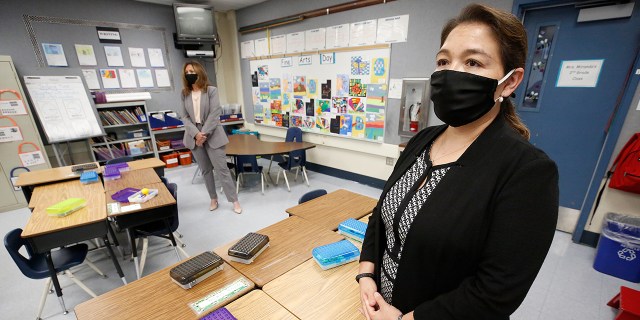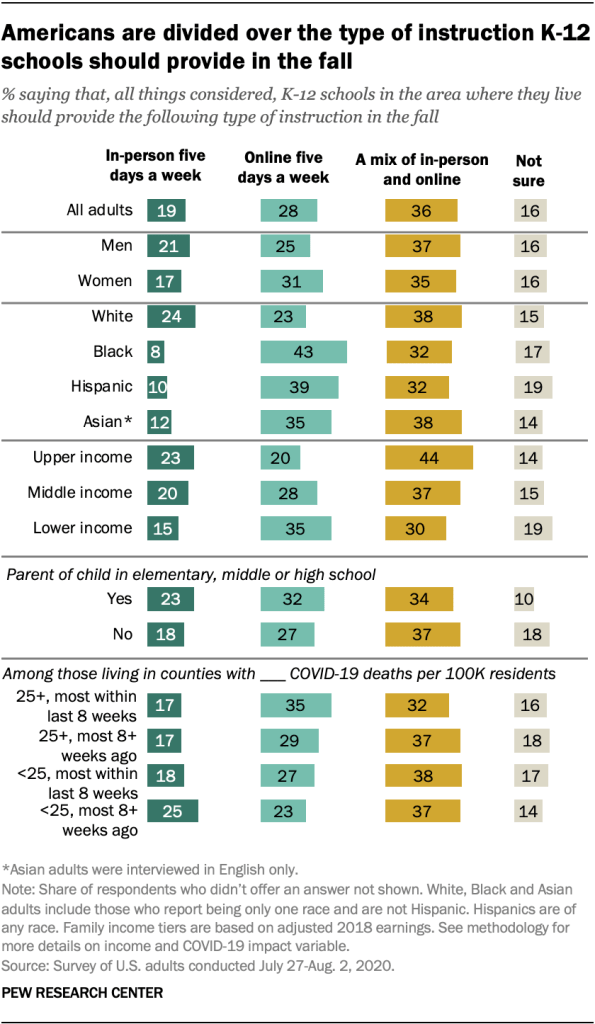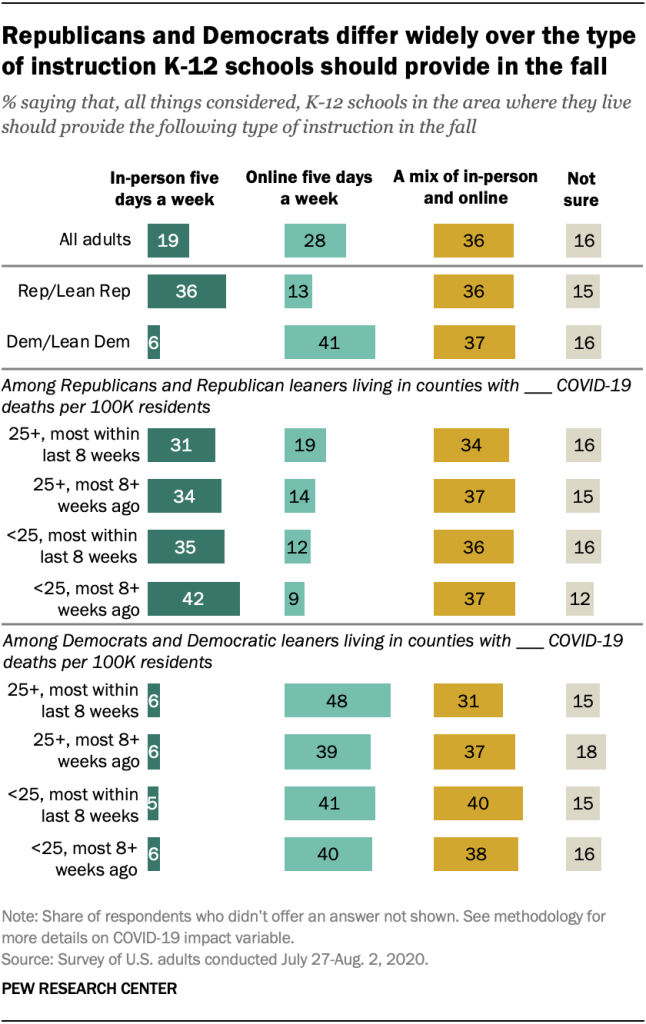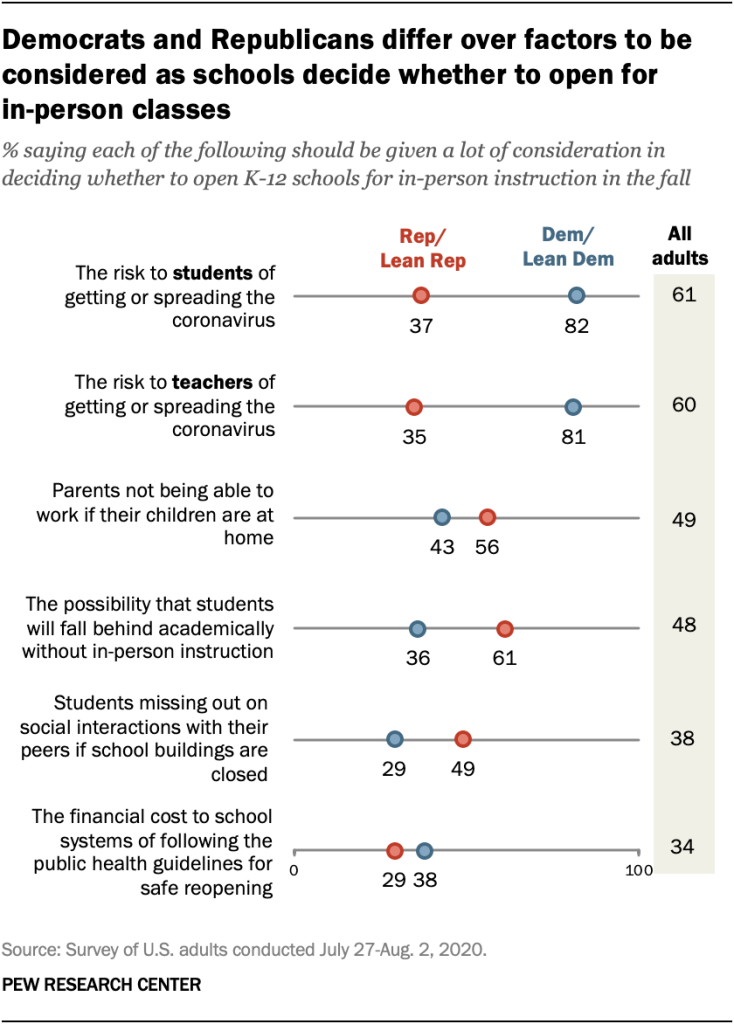
Americans have mixed views about whether K-12 schools in their area should offer in-person instruction, online instruction or a combination of both as the coronavirus outbreak intensifies across much of the country. And while the public sees health risks to students and teachers as the top factor that should be given a lot of consideration as schools decide whether to reopen, there are wide partisan gaps in these views, according to a new Pew Research Center survey.
Overall, about three-in-ten U.S. adults (28%) say that, all things considered, K-12 schools in the area where they live should provide online instruction five days a week in the fall, while a smaller share (19%) say schools should provide in-person instruction five days a week. The largest share of Americans (36%) say K-12 schools in their area should provide a mix of online and in-person instruction.
Among parents with children who will be enrolled in elementary, middle or high school in the fall, 32% say K-12 schools in their area should offer online instruction five days a week, while a similar share (34%) say schools should offer a mix of online and in-person instruction. About a quarter of these parents (23%) say schools in their area should offer in-person instruction five days a week.
To explore Americans’ views about how K-12 schools should offer in-person instruction, online instruction or a mix of in-person and online instruction this fall, we surveyed 11,001 U.S. adults from June 27 to Aug. 2, 2020. Everyone who took part is a member of Pew Research Center’s American Trends Panel (ATP), an online survey panel that is recruited through national, random sampling of residential addresses. This way, nearly all U.S. adults have a chance of selection. The survey is weighted to be representative of the U.S. adult population by gender, race, ethnicity, partisan affiliation, education and other categories. Read more about the ATP’s methodology. Here are the questions used for this analysis, along with responses, and its methodology.
White adults are the most likely to say K-12 schools in their area should offer in-person school five days a week: 24% say this, compared with about one-in-ten Black (8%), Hispanic (10%) and Asian (12%) adults. Among Black Americans, 43% say that, all things considered, schools in their area should provide online instruction five days a week, as do 39% of Hispanic Americans and 35% of Asian Americans. About a quarter of white Americans (23%) share this view.
Opinions also vary by income, with lower-income adults (35%) more likely than those with middle (28%) or upper (20%) incomes to say K-12 schools in their area should provide online instruction five days a week. In turn, pluralities of middle-income (37%) and upper-income (44%) adults say schools in their area should provide a mix of online and in-person instruction.
Those who live in counties that have been hit hard by the coronavirus recently are the most likely to say K-12 schools in their area should provide online instruction five days a week: 35% in these counties say this, compared with 29% of those in places that were hit hard earlier in the outbreak; 27% in less hard-hit counties that have seen most of their COVID-19 deaths within the last eight weeks; and 23% in less hard-hit counties that experienced the most deaths earlier in the pandemic.
There are even wider partisan gaps in views of what schools should do in the fall. Some 36% of Republicans and Republican-leaning independents say that, all things considered, K-12 schools in their area should offer in-person instruction five days a week; just 6% of Democrats and those who lean Democratic say the same. And while 41% of Democrats say schools should offer online instruction five days a week, just 13% of Republicans agree. Similar shares of Republicans and Democrats say schools in their area should offer a mix of in-person and online instruction.
Democrats and Republicans in counties that have been hit hard by the coronavirus outbreak in recent weeks are more likely than their counterparts in places that were hit hard earlier in the pandemic or that have not been as hard hit to say K-12 schools in their area should provide online instruction five days a week in the fall. Still, there are large partisan differences in counties that have been hard hit and in those that haven’t.
For the most part, the partisan and demographic differences observed among all U.S. adults in views of the type of instruction K-12 schools should offer exist among those who will have children enrolled in elementary, middle or high school in the fall.
Asked how much a series of factors should be considered in deciding whether to open K-12 schools for in-person instruction in the fall, about six-in-ten U.S. adults say the risk to students (61%) and teachers (60%) of getting or spreading the coronavirus should be given a lot of consideration. About half say a lot of consideration should be given to parents not being able to work if their children are at home (49%) and the possibility that students will fall behind academically without in-person instruction (48%). Smaller shares say the same about students missing out on social interactions with their peers (38%) and the financial cost to school systems of following the public health guidelines for safe reopening (34%). Majorities of about three-quarters or more say each of these factors should be given at least some consideration.
Democrats and Republicans point to different factors when it comes to decisions about whether to open K-12 schools for in-person instruction. About eight-in-ten Democrats say the risk to students (82%) and teachers (81%) of getting or spreading the coronavirus should be given a lot of consideration, far more than the shares of Republicans who say the same (37% and 35%, respectively). Democrats are also more likely than Republicans to say a lot of consideration should be given to the financial cost to school systems of following the public health guidelines for safe opening (38% vs. 29%).
In turn, Republicans are more likely than Democrats to say a lot of consideration should be given to the possibility that students will fall behind academically (61% vs. 36%), parents not being able to work if their children are at home (56% vs. 43%) and students missing out on social interactions with their peers (49% vs. 29%).
Lower-income adults are the most likely say a lot of consideration should be given to the health risks to teachers (68%) and students (66%), as well as the financial cost to school systems of following public health guidelines (42%). About six-in-ten middle-income adults point to the risk to students (59%) and teachers (58%), while 55% of upper-income adults say each of these factors should be given a lot of consideration. Those with upper incomes are the least likely to say the same about the financial cost to school systems of following public health guidelines (24% of upper-income adults say this, as do 32% of middle-income adults).
Parents of children who will be in elementary, middle or high school in the fall are more likely than other Americans to say nearly all of the factors asked about in the survey should be given a lot of consideration, with differences ranging from 4 to 8 percentage points. For example, 54% of K-12 parents say the possibility of students falling behind academically without in-person instruction should be given a lot of consideration, compared with 46% of those who won’t have children in K-12 schools in the fall. And while 44% of parents say a lot of consideration should be given to the possibility that students will miss out on social interactions with their peers, 36% of those who are not parents of K-12 students say the same. Similar shares in each group say the risk to teachers of getting or spreading the virus should be given a lot of consideration.
Note: Here are the questions used for this analysis, along with responses, and its methodology.



